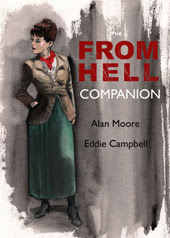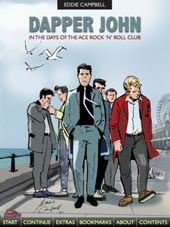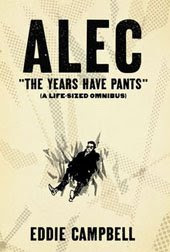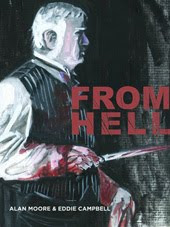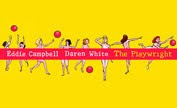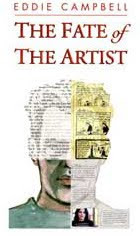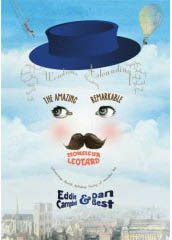A t the time I did worry that putting all these real life people into a Bacchus story would severely hamper the chances of the book's survival as a comprehendible read. Because nowadays we comickers think a great deal about shelf life. Perhaps too much. (is it another one of the negatives of the graphic novel era?).
But then, I reasoned, what sort of future would it be where my Bacchus is not at least still as well known as Alan Moore? Following is part of a two page scene in which Neil Gaiman, having been sent downstairs at the Castle and Frog by Bacchus, is telling Alan Moore that it's time to release the screamin' habdabs. The scene is actually an analogue of a real life event in which Alan described to Neil his intentions for the final murder in From Hell and Neil came over so nauseous that he had to leave the house.

Many people have sought me out at conventions to try to get hold of King Bacchus just for this scene. Far from hampering the future readability of the book, this may indeed be all that it is ever remembered for. Well, that and the four page spread...
I am reminded of
George Du Maurier's Trilby, a book I have on my shelf, a late Victorian melodrama, hugely popular in its time, which is now mainly remembered for stuff that happened outside of the pages.
Du Maurier, in his weekly cartoons in Punch, liked to poke fun at the 'aesthetic movement', the doings of the likes of James McNeil Whistler, Oscar Wilde and Dante Gabriel Rosetti. He had actually studied art in Paris alongside Whistler and inserted the soon-to be-famous painter into his first sale to Punch in the 1960s.

Du Maurier's lampoons of the 'aesthetics' peaked in 1880, by which time he had developed a whole cast of recurring characters, such as the languid poet Prigsby, clearly modelled on Wilde.

Du Maurier turned himself into a novelist, and his second book,
Trilby caused a minor furore when it was serialized in 1894 in Harper's Weekly in the USA before publication in book form. James Whistler recognized himself in the Character Joe Sibley and threatened to sue for libel unless the character was removed and all existing copies of the issue of the magazine destroyed. The character was removed and replaced by another, and the illustrations in which Sibley appeared were not used when the book was published. No apology was made. This appears to be the drawing that caused the trouble, an update of Hogarth's idle and industrious apprentices.

Trilby inspired Gaston Leroux's novel The Phantom of the Opera (1910) and introduced the phrase "in the altogether" (nude) and the term "Svengali" for a man with dominating powers over a female protege, as well as indirectly inspiring the name of the Trilby hat, originally worn on stage by a character in the play. There was a book about it all,
Trilbyana (1910).
Why did Whistler think suing somebody might be a good idea? There was his earlier lawsuit against the critic Ruskin, who had written, "
I have seen, and heard, much of Cockney impudence before now; but never expected to hear a coxcomb ask two hundred guineas for flinging a pot of paint in the public's face." Whistler won but was awarded a mere one farthing in damages. The costs of mounting the suit wiped him out. Wilde, you will recall, is another who mistakenly thought suing a worthwhile enterprise, and who lost everything.
Labels: A Big Spread





















